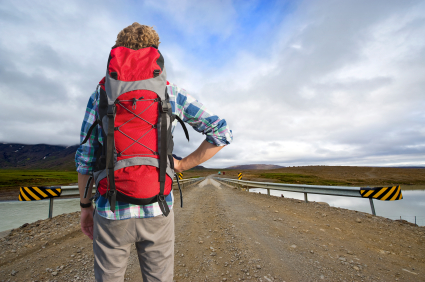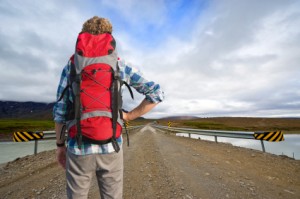 [1]There’s always much ado about the bug-out bag [2], but there’s another important bag that we are more likely to use – the “Get-Home Bag”.
[1]There’s always much ado about the bug-out bag [2], but there’s another important bag that we are more likely to use – the “Get-Home Bag”.
Most people spend up to 60 hours per week either being at work, going to work, or coming home from work. That’s nearly 30% of your life, spent away from home. If you calculate in the time that you sleep, just over half of your waking hours are spent on the job. For those who moved to a more remote area and chose to commute, the time spent away increases even more.
With these odds, it’s not unreasonable to believe that when the SHTF, you just might be at work.
Make a Plan!
As with any preparations, it’s important to have a plan. First things first, you should discuss with your household how everyone is going to get home if an event occurs during the day when everyone is out doing his or her business. It’s vital to know what the other family members will do so that you don’t duplicate efforts, particularly if communication is down. Depending on the situation, driving may not be an option. It’s important to map more than one route and to be able to make the trek on foot.
Next, you need to create a get-home bag that is unique to each family member’s likely circumstances. Because you would have planned ahead (see above paragraph) your route home, as well as an alternate route, you will already know how long it will take you to get home. You can use this knowledge to help plan the contents of your bag.
What Should Your Bag Contain?
For most of us, a get-home bag needs to contain the essentials for 24-48 hours on the road, on foot. Therefore, you need to consider your basic necessities:
Water: Water is one of the most crucial items in any disaster situation. It’s also heavy. Therefore, while you should carry a few bottles of drinking water, you should also have some secondary methods for acquiring potable water. It is vital to have a portable filter and water purification tablets on hand to purify water on the move.
Food: Lightweight foods such as Datrex bar, MRE, freeze dried or dehydrated food will keep you bag’s weight down and provided needed nutrition. For more suggestions on nutrition during emergency scenarios and what foods to consider, read The Bug-out Meal Plan [3].
Shelter: The type of shelter you need is variable, based on climate, location and season. If your area is likely to reach freezing temperatures overnight, you need to supply yourself accordingly, including a highly rated sleeping bag and decent quality tent. If the weather is more moderate, a light space blanket, a lightweight bivvy sac [4], and makeshift shelter may be sufficient.
Personal defense items: Depending on your location and your local laws, you may be able to have a firearm [5] in your bag. If you can pack a gun, be sure to store it safely and to also bring a sufficient supply of ammunition. Other self defense items might include: mace, pepper spray, a knife, bear spray, a baton, a nightstick, or a steel pocket stick. Another option is a heavy walking stick.
Tools: As always having the right tools [6] can be essential to survival. Try to find items that can perform more than one task to save space and reduce weight. A large hunting knife, a multi-tool, fire starting devices (matches, lighters, flints), a compass, duct tape, map, carabiner, zip ties, and rope or sturdy cord should all be contained in your get-home bag.
Comfortable gear: Be sure to pack suitable clothing for the climate and season. You will require comfortable walking shoes (boots [7] if there is a lot of snow, extreme cold, or risk of snakes), a suitable coat, a rain poncho, and layering items. Also bring essential clothing [8] such as scarves, hats, and gloves, and never forget the importance of extra socks.
Lighting: Very little light makes for a more uncomfortable night in the forest compared to sitting in complete darkness. A flashlight, lightweight lantern or light stick can brighten things up for performing vital tasks. Tea light candles or votives are also good additions. Consider some of these alternative lighting sources [9].
First Aid Supplies: Besides basics like bandages, antibacterial spray, and ointments, considers adding some pain relievers (like aspirin, acetomenaphen, or ibuprofen), heartburn medication, electrolyte powders [10], anti-diarrheals and even bandages for blisters would be very advantageous if a medical situation call for it.
Hygiene supplies: Personal hygiene can keep you from becoming ill during your journey. Baby wipes are a good substitute for toilet paper and can also be used for washing your hands or wiping your flatware before and after eating. Hand sanitizers [11] would also be a good choice to have.
Personal necessities: This will vary based on the person, but some examples might be prescription medications, feminine hygiene products, contact lens solution, and glasses. Don’t forget money – stash some small bills in your bag in a way that you can take out one at a time without letting people know you have more.
Communications – Most people already have a cell phone – but be sure that you have an extra charged battery pack. Also consider a hand held radio to get access to public information
Do a Test Run
When planning your get-home kit, it’s important to consider the weight of the bag in comparison to your fitness level. It’s a good idea to hike with this bag occasionally to begin conditioning your body to hauling the load. When you do this, you can judge several things:
- Is the weight of the bag manageable?
- Is the bag comfortable to carry? (Far better to find out now that the straps dig into your shoulders than when you are in an emergency situation!)
- Are all of the contents of your bag essential?
And on a related note:
Is your cardiovascular conditioning sufficient [12] to get you home?
Where Should You Keep Your Get Home Bag?
Your get-home bag should be located in a place that it’s easy to access. Some people stash their bag in the office, which is a good solution if you commute via public transit or carpooling. However, a disaster could strike while you’re on the road to or from work, so you should consider storing it in your trunk or having a duplicate bag in your vehicle.
An option for those who have a long journey home would be to cache survival supplies at points along their route. This can be an entire get-home bag or small stashes of things that you may have used up, like food or ammunition. You can learn more about setting up survival caches here [13]
Another Layer of Preparedness
A get-home bag is just another layer of preparedness. A person who is truly prepared is ready no matter where they are. Being stocked up and mentally prepared to walk home in the event of a disaster puts you ahead of the “Golden Horde” that is likewise trying to get out of the city. You won’t have to waste time figuring out how to get home on foot, bemoaning your uncomfortable shoes or wishing you had a proper coat – you’ll be halfway to your destination before the other folks realize the gravity of the situation.
The world is a very unpredictable place where we must accept that some situations are out of our control. With that in mind, they may be out of our control – but we can be prepared for them.
